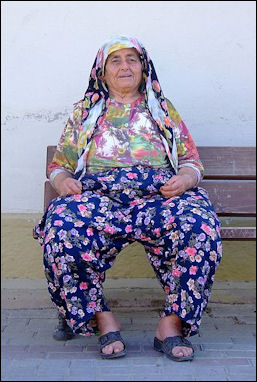Home | Category: Muslim Women / Arab Women
ISLAM, FEMININE MODESTY AND VEILS
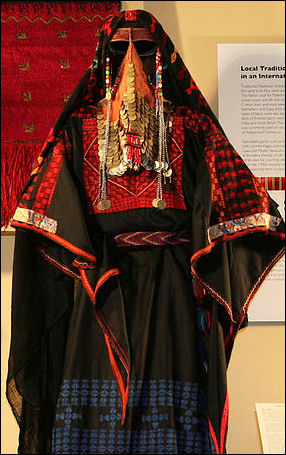
Burqa in Bersheba Islam teaches feminine modesty, and this is interpreted in different ways, from a women covering every inch of her body and face, to covering her hair and most of her body, to not dressing like a prostitute. “Hejab” (“hijab” , “Islamic Dress”) is a generic term for modest dress worn by Muslim women. The only parts of the body allowed to be exposed are the hands, feet and face. Sometimes “ hijab” is used to describe a scarf that wraps around the head. The hair is covered partly because it is regarded as erotic.
In some Muslim societies women cover all or part of their face with a veil or some other covering. These veils and head coverings scarves go by different names in different places. Girls generally begin wearing them after reaching puberty. Veiling also extends to behavior. Women instinctively cover their faces with their veils or head scarves when they speak. When a man enters a room they are in they instinctively turn away or cover their faces.
In many Muslim societies women are forbidden from exposing their heads, hair, neck and the curves of their body in public. Even in the hottest places women are supposed to wear long sleeves, and long billowing non-transparent skirts and dresses that hide the curves of their body and make even women with the nicest fugues look overweight. Doctors in Iran have linked covering the body to shortages in Vitamin D, usually derived from sunlight, and increases in osteoporosis.
Figure-concealing garments often vary and have different names in different places. The “abaya” or “chador” is cloak that covers a woman from head to toe. It can be combined with separate pieces that covers the face — "nikab” — or a tent-like covering — “burqa”. The jilbab is a loose, dress-like out garment designed to cover the wearer’s clothes.
Cosmetics, jewelry and perfume and anything that makes a woman alluring are also discouraged. One reason women veil themselves is so that they will not tempt men and maintain their chastity and honor and the chastity and honor of the men around them.
Websites and Resources: Islam IslamOnline islamonline.net ; Institute for Social Policy and Understanding ispu.org; Islam.com islam.com ; Islamic City islamicity.com ; BBC article bbc.co.uk/religion/religions/islam ; University of Southern California Compendium of Muslim Texts web.archive.org ; Encyclopædia Britannica article on Islam britannica.com ; Islam at Project Gutenberg gutenberg.org ; Muslims: PBS Frontline documentary pbs.org frontline
RECOMMENDED BOOKS:
“Muslim Women & The Hijab Veil: Oppression or Liberation?’ by The Sincere Seeker Amazon.com ;
“Woman's Hijab” by Darussalam and Shaikh Muhmmad bin Salih Al Uthaimeen Amazon.com ;
“Mirror on the Veil: A Collection of Personal Essays on Hijab and Veiling” by Nausheen Pasha-Zaidi and Shaheen Pasha Amazon.com ;
“The Routledge International Handbook to Veils and Veiling” by Anna-Mari Almila and David Inglis Amazon.com ;
“Veiling in Africa” by Elisha P. Renne Amazon.com ;
“Islamic Dress Code for Women” by Darussalam Res Amazon.com ;
“Girl in the Tangerine Scarf” by Mohja Kahf Amazon.com ;
“Muslim Girl: A Coming of Age” by Amani Al-Khatahtbeh Amazon.com ;
“It's Not About the Burqa: Muslim Women on Faith, Feminism, Sexuality and Race”
by Mariam Khan Amazon.com ;
“A Muslim Woman's Diary” by Sumaya Amiri Amazon.com ;
“Nine Parts of Desire: “The Hidden World of Islamic Women” by Geraldine Brooks Amazon.com ;
“Muslim Woman's Participation in Social Life” by Abd al-Halim Abu Shuqqah and Adil Salahi Amazon.com ;
“Women in Islam: What the Qur'an and Sunnah Say” by Abdur Raheem Kidwai Amazon.com
Hijab
Hijab is the principle of modesty in Islam and includes behaviour as well as dress for both males and females. According to the BBC: “Hijab is an Arabic word meaning barrier or partition. In Islam, however, it has a broader meaning... The most visible form of hijab is the head covering that many Muslim women wear. Hijab however goes beyond the head scarf. In one popular school of Islamic thought, hijab refers to the complete covering of everything except the hands, face and feet in long, loose and non see-through garments. A woman who wears hijab is called Muhaajaba. Muslim women are required to observe the hijab in front of any man they could theoretically marry. This means that hijab is not obligatory in front of the father, brothers, grandfathers, uncles or young children. Hijab does not need to be worn in front of other Muslim women, but there is debate about what can be revealed to non-Muslim women. [Source: BBC, September 3, 2009 |::|]
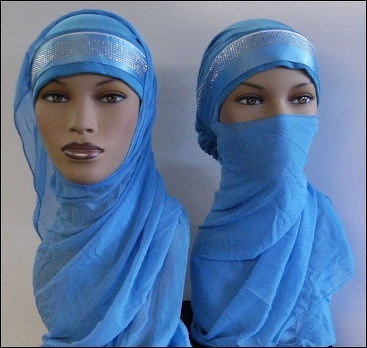
Hijab on the left, niqab on the right
Hijab is the principle of modesty in Islam and includes behaviour as well as dress for both males and females. According to the BBC: “Hijab is an Arabic word meaning barrier or partition. In Islam, however, it has a broader meaning... The most visible form of hijab is the head covering that many Muslim women wear. Hijab however goes beyond the head scarf. In one popular school of Islamic thought, hijab refers to the complete covering of everything except the hands, face and feet in long, loose and non see-through garments. A woman who wears hijab is called Muhaajaba. Muslim women are required to observe the hijab in front of any man they could theoretically marry. This means that hijab is not obligatory in front of the father, brothers, grandfathers, uncles or young children. Hijab does not need to be worn in front of other Muslim women, but there is debate about what can be revealed to non-Muslim women. [Source: BBC, September 3, 2009 |::|]
The late Dr. Mahmood Abu Saud, a well-known Islamic scholar, said: : The word "hijab" is used in the Holy Qur'an in its linguistic original sense, i.e., a barrier, something to separate two things from one another. The Prophet's wives were ordered by God to observe hijab, meaning not to face all mature males who are entitled to marry them. They had to speak to such males from behind a curtain or a door so nobody would see them. [Source: “Sexuality in Islam” by Heba G. Kotb M.D., A dissertation presented to Maimonides University, 2004]
"In our times, the word is usually used to indicate the dress of a woman in accordance with the Islamic requirements. What is definite for man and woman is that neither gender should dress or act in a way that is intended to attract the attention of the opposite sex. By instinct, males are more attracted to females' bodies than vice versa. Accordingly, Islam ordained that women should not show of their bodies what would particularly attract the attention of males. Besides, they should not show of their adornment other than that conventionally shown by women in an Islamic society. As for the degree of sin, it depends upon the degree of violating these rules and the intention of the female who violates them. There are no fast rules determining the details of how to dress and cover other than to be modest and not show off.
Shahid Athar, a well known Muslim American psychiatrist at the at the Islamic Center in Toledo, Ohio, said in 1992: "hijab is an injunction from God (33:59). The extent of hijab can be questioned. However, obeying/disobeying an injunction altogether is a reflection of the faith of the person. The degree of sin or forgiving is up to the Law Maker."
Hijab and Modesty Rules
According to the BBC: ““Modesty rules are open to a wide range of interpretations. Some Muslim women wear full-body garments that only expose their eyes. Some cover every part of the body except their face and hands. Some believe only their hair or their cleavage is compulsory to hide, and others do not observe any special dress rules. [Source: BBC, September 3, 2009 |::|]
“In the English speaking world, use of the word hijab has become limited to mean the covering on the head of Muslim woman. However, this is more accurately called a khimaar. The khimaar is a convenient solution comprising usually one, but sometimes two pieces of cloth, enabling Muslim women to cover their hair, ears and neck while outside the home. |Hijab, in the sense of veiling, can also be achieved by hanging a curtain or placing a screen between women and men to allow them to speak to each other without changing dress. This was more common in the early days of Islam, for the wives of the Prophet Muhammad. |::|
The Qur'an gives these general rules, which may help in understanding how to interpret dress and other rules in modern times. “O ye Children of Adam! We have bestowed raiment upon you to cover your shame, as well as to be an adornment to you. But the raiment of righteousness,- that is the best. Such are among the Signs of Allah, that they may receive admonition!” — Qur’an 7:26 So clothing does not have to be drab: it is all right for both sexes to use clothing to enhance beauty as well as to cover nakedness. The most important thing is to be modest and righteous.
Dr. Mahmood Abu Saud said: “Slave women during the days of the Prophet even used to pray without covering their hair. Men never were seen uncovering their hair in public, but that was a societal convention. The idea of covering hair is the same as covering the adornment and the body of the woman. In simple words, as women are very proud of their hair and do consider it a part of their beauty that attracts the attention of men, it is then supposed to be covered. [Source: “Sexuality in Islam” by Heba G. Kotb M.D., A dissertation presented to Maimonides University, 2004]
Origin of Veiling
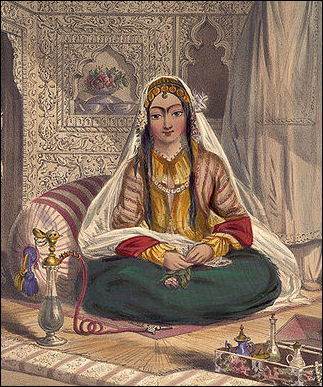
Afghan lady in Kabul There is some debate as to when the custom of Muslim veiling began and where the custom originated . Some conservative Muslims have insisted that veiling was practiced in Muhammad’s time and Muhammad’s wives veiled themselves. There is little evidence of this though.
Some say the custom of veiling was adopted by Muslims about three of four generations after Muhammad’s death and is believed to have been copied from the Byzantines or perhaps from India or Persia. Veiling has also been practiced for a long time by Hindus from India, where women seclude and veil themselves through a custom called purdah, which was originally adopted by the upper classes and became a status symbol.
In any case the custom of veiling predates Islam. In antiquity it was a sign of high status. Jewish and Christian women adopted the custom to symbolize a retreat from public life. The Iranian term chador, meaning “tent.” is derived from the personal custom of very wealthy women traveling around in covered sedan chairs. Some people have said the Western custom of brides wearing veils come from Muslim countries. More likely it comes from ancient Greece. The veiling and segregation of women was common practice among women in ancient Greece, Rome and Byzantium.
“When the Qur'an first mentioned the concept of hijab, it was not as a veil or headscarf. Hijab was used in the context of a barrier or screen as in this Qur'anic verse: ‘(...) And when ye ask (the Prophet's wives) for anything ye want, ask them from before a screen: that makes for greater purity for your hearts and for theirs.’ — Qur’an 33:53
“Taken in historical context, this verse seems to have been primarily intended to give the Prophet's wives some protection against nuisance visitors and people who were looking for gossip about them. Gossip and slander were a great concern at the time the verses relating to hijab were revealed. One set of verses (24:1 onwards) came immediately after the Prophet's wife Aisha was accused and acquitted of adultery.
History of Veiling
In the old days veiling was more common in the cities than in villages, presumably because city women were more likely to be secluded and pampered than rural women who needed to work in the fields and veiling and covering themselves made such work more difficult. In the cities it seems that women often were the ones that demanded they be veiled as a means of escaping harassment and showing their status.
Lynn Reese wrote in “Women in the Muslim World,” “Muslims in their first century at first were relaxed about female dress. When the son of a prominent companion of the Prophet asked his wife Aisha bint Talha to veil her face, she answered, "Since the Almighty hath put on me the stamp of beauty, it is my wish that the public should view the beauty and thereby recognized His grace unto them. On no account, therefore, will I veil myself." “As Islam reached other lands, regional practices, including the covering of the faces of women, were adopted by the early Muslims. Yet it was only in the second Islamic century that the face veil became common, first used among the powerful and rich as a status symbol. [Source:“Women in the Muslim World,” ed. Lynn Reese, 1998]
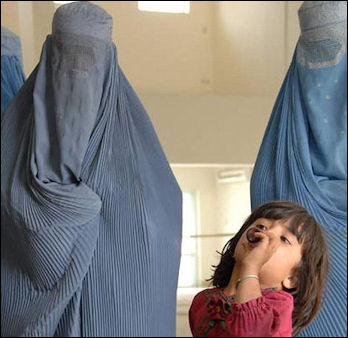
Burqa in Afghanistan Various forms of veiling and head covering was the norm throughout the Muslim world until social customs began liberalizing under European rule and the nationalist movements in the 20th century. In 1934, Turkey under Mustafa Kemal Ataturk, became the first Muslim country to ban the veil in his attempt to modernize his country. In 1936 in Iran, Reza Shah Pahlavi ordered the mass unveiling of women and ordered police to literally tear the veils off women on the streets. Although some women welcomed the changes other were adamantly against it, staging sit ins and protests and refusing to leave their homes until eventually the ban being rescinded in 1941.
Still in the 1960s and 1970s veiling was not widely practiced by urban women in places like Iraq, Iran, Lebanon, Egypt and the Palestinian territories. The custom made a come back with the revival of Islamic sentiments after the Iranian Revolution in 1979 and the Intafadeh in the Palestinian territories in the 1990s and was embraced more strongly when anti-Western sentiments grew after the invasion of Iraq in 2003.
A women in Florida was denied a driver’s license because she refused to be a photographed without her face veiled. After the attack on the World Trade Center in New York on September 11, 2001 she was told had to have her photograph taken without a veil or the licence would be revoked. Instead of complying she sued on the basis of freedom of religion.
Qur’an on Hijab
The justification for veiling comes from several verses in the Qur’an. The first one goes: "O Prophet, tell your wives and daughters and the believing women to draw their outer garments around them (when they go out or are among young men). That is better, in order that they may be understood (to be Muslims) and not annoyed."
.jpg)
burqa in Bamdar Abbas (south Iran) The Qur’an does not spell out details about how woman should be covered and does specify any punishment for women who are not veiled. Nowhere does it say in the Qur’an that a woman should cover face, head or hair. The justification for the use of facial veils come from verse 24:31 in the Qur’an which reads:"And say to the believing women, to lower their gaze and guard their private parts and reveal not their adornment save such as is outward; and let them draw their veils over their bosoms and not display their beauty except to their husbands."
On modesty the Qur’an says that "true modesty is the source of all virtues" and "modesty and chastity are parts of the Faith." In an order to men visiting the home of the prophet: “When ye ask [the wives of the Prophet] for any article, ask them from behind a curtain; that is purer for their hearts and yours.”
According to the BBC: “The Qur'an makes a few references to Muslim clothing, but prefers to point out more general principles of modest dress. “Both men and women are commanded to lower their gaze and "guard their modesty". The most basic interpretation of "guard their modesty" is to cover the private parts, which includes the chest in women ("draw their veils over their bosoms"). However, many scholars interpret this injunction in a more detailed way and use Hadith (recorded sayings of the Prophet Muhammad) to support their views. [Source: BBC, September 3, 2009 |::|]
“Say to the believing men that they should lower their gaze and guard their modesty: that will make for greater purity for them: And Allah is well acquainted with all that they do.” — Qur’an 24:30
“And say to the believing women that they should lower their gaze and guard their modesty; that they should not display their beauty and ornaments except what (must ordinarily) appear thereof; that they should draw their veils over their bosoms and not display their beauty except to their husbands, [a list of relatives], [household servants], or small children who have no sense of the shame of sex; and that they should not strike their feet in order to draw attention to their hidden ornaments. And O ye Believers! turn ye all together towards Allah, that ye may attain Bliss. ) — Qur’an 24:31
Interpretation of the Veil Custom
Selchuk woman Veiling was institutionalized by Sharia (Islamic law). The way the body should be covered is based on the Hadiths. The wide variety of types of coverings in the Islamic world is a clear indication of how varied interpretations of the Qur’an and Hadiths can be. Men have a dress code too. The Qur’an forbids them from wearing saffron and silk or exposing skin from naval to knee.
The Qur’an specifically warns against literal interpretations. One of the reason why that so many restrictions are put on women is the belief among some Muslims that when God divided up sexual desire he gave women nine times more than men.
Many women on the hajj do not wear veils. Girls can go to school without wearing the veils because of the belief that their uniforms meet the modesty requirements of Sharia. Some women wear the veil as a kind of political statement to show their solidarity with other Muslims, especially as a response to perceived American and Israeli aggression.
France has banned the veil in schools. In the United States, a woman was given a ticket for wearing a veil in Minnesota and an 11-year-old girl was kicked out of school in Oklahoma for wearing one (the federal government acted to get her readmitted) . In Canada, women have been barred from courtrooms for wearing head scarves. In multi-cultural Trinidad, Muslim women are not allowed into state-supported Catholic, Protestant and Hindu schools if they wear head scarves. A 1987 study in Yemen found that women who watched Western programs on television were more likely to question wearing the veils.
Mr. Dalil Boubakeur, former rector of the Paris Grand Mosque, and the practice of wearing a burqa and completely covering the face and body “rests upon an interpretation of the Qur’an and of the Muslim tradition that is very questionable and held by a minority.” Boubakeur testified that “the term burqa exists in the Arab literature available before Islam” and that “it is an archaism that has nothing to do with Islam.” As for the niqab, he testified that it originally was a piece of clothing designed to protect oneself from the sun, the wind, and sand. He further states that “certain scholars succeeded in imposing the niqab at the beginning of the 20th century in Saudi Arabia.” According to Boubakeur and other Islamic scholars “only the Islamic scarf covering the head and the neck could be considered as conforming to the principles of Islam.” [Source: Library of Congress Law Library, Legal Reports, 2010 |*|]
See Separate Article: VIEWS ABOUT HIJAB AND MUSLIM VEILING africame.factsanddetails.com
Zeenah and Khimaar
According to the BBC: “Zeenah (ornaments) is another word with numerous meanings. It has been interpreted to mean body parts, beauty, fine clothes or literal ornaments like jewellery. (The same word is used in chapter 7:31 - "O Children of Adam! wear your beautiful apparel at every time and place of prayer..."). The jewellery interpretation is supported by the instruction to women not to stamp their feet to draw attention to themselves. It used to be the practice among Arabian women to wear ankle chains to attract men. The word translated here as veils is khumur, plural of khimaar. According to scholars, the word khimaar has no other meaning than a type of cloth which covers the head. Muslim scholars point out that men's turbans are sometimes called khumur as well.[Source: BBC, September 3, 2009 |::|]
“Women during the time of Muhammad did wear the khimaar, but would wear it tied behind so their neck and upper chest were visible. This verse is therefore an order that the khimaar now be drawn over the chest, so that the neck and chest were not bare. |::|

According to the BBC: “According to most scholars, the khimaar is obligatory for Muslim women. The phrase "what must ordinarily appear thereof" has been interpreted in many different ways. Among Muslims who take the word zeenah (ornaments) to refer to body parts, a popular interpretation of this phrase is that women should only show the body parts that are necessary for day-to-day tasks. This is usually taken to be the face and the hands.[Source: BBC, September 3, 2009 |::|]|
“Some scholars recommend hiding everything but the eyes. The style of burqa worn by Afghan women even hides the eyes. Muslims who oppose full concealment say that if Allah wanted women to hide their entire bodies, there would have been no need to tell male Muslims to lower their gaze. |::|
“But "what must ordinarily appear thereof" could be understood as meaning the parts of the body that are shown when wearing normal (modest) dress, with the definition of normal dress deliberately left up to the believers' particular time and culture. This could explain why the Qur'an is not more specific: if God had wanted to, he could have listed the acceptable body parts in as much detail as the list of exceptions to the rule. |::|
“Some scholars interpret "what must ordinarily appear thereof" to mean that if a woman exposes part of her body by accident, she will be forgiven. All agree that women will not be punished for breaking the rules if some emergency forces them to do so. |::|
“Cast Their Outer Garments over Their Persons”
“O Prophet! Tell thy wives and daughters, and the believing women, that they should cast their outer garments over their persons (when abroad): that is most convenient, that they should be known (as such) and not molested. And Allah is Oft- Forgiving, Most Merciful. — Qur’an 33:59
According to the BBC: “This verse is directed to all Muslim women. An alternative translation is "they should lengthen their garments". The word translated here as "outer garments" is jalabib, the plural of jilbab. But it does not necessarily refer to the present day garment known as jilbab. Translators usually represent the word jalabib with general terms like cloaks or outer garments. |[Source: BBC, September 3, 2009 |::|]
“The two most common scholarly interpretations of jilbab are a travelling coat or cloak and a sheet-like full body garment similar to the modern jilbab. Some insist that the Qur'anic meaning of jilbab is identical to the present day garment. Others maintain that today's garment was developed as late as 1970 by the Muslim Brotherhood in Egypt. |::|
“The verse also indicates that the purpose of dressing this way is that women are recognised as Muslims and not harassed. It was not very safe for women to go out during this time when they could be mistaken for prostitutes or assaulted. |::|
“The rules are relaxed for elderly women: )”Such elderly women as are past the prospect of marriage - there is no blame on them if they lay aside their (outer) garments, provided they make not a wanton display of their beauty: but it is best for them to be modest: and Allah is One Who sees and knows all things.” — Qur’an 24:60
Hijab Rules on What Women Can Show in Front of Different People
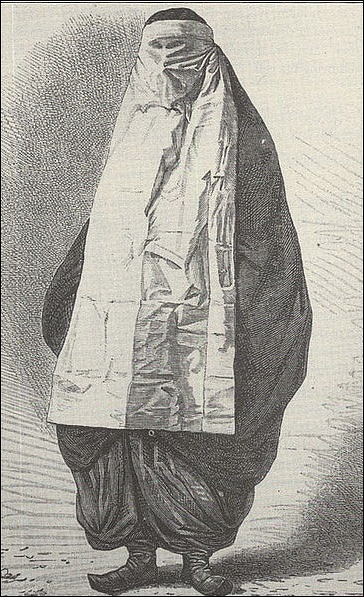
old chador engraving
“The Arabic word awrah refers to the parts of the body which must be covered with clothing. Awrah is any part of the body, for both men and women, which may not be visible to the public. Awrah is interpreted differently depending upon the sex of the company one is in. Most Muslims accept that for men everything between the navel and the knee is awrah and therefore should be covered at all times. [Source: BBC]
According to the BBC: There are a number of hijab scenarios for women: 1) In front of unrelated men (Muslim or non-Muslim), women must cover everything except the hands and face; 2) In front of close male relatives, awrah is the navel to the knee and the stomach and the back; 3) In front of other Muslim females, awrah is from the navel down to, and including, the knees; 4) Awrah in front of non-Muslim women is a point of debate: 5) Some scholars say that women should cover all but the hands and face. This is to prevent non-Muslim women (who may not understand the rules regarding hijab) from describing the appearance of the hijab wearer to other men; 6) Other scholars say that if a non-Muslim woman can be trusted not to describe a woman's appearance to other men, then she may reveal as much as she would in front of another Muslim woman in her presence. |::|
“The Hanafi school of thought, which is followed by most Muslims in the world, agree that the feet are not part of the awrah and therefore may be revealed. Amongst other schools of thought a common opinion is that everything apart from a woman's face and hands is awrah. Scholars holding this opinion use this hadith to justify it: “Narrated Aisha (the Prophet's wife): Asma, daughter of Abu Bakr, entered upon the Apostle of Allah (peace be upon him) wearing thin clothes. The Apostle of Allah (peace be upon him) turned his attention from her. He said: 'O Asma, when a woman reaches the age of menstruation, it does not suit her that she displays her parts of body except this and this, and he pointed to her face and hands.” — Abu Dawud, Book 32, Number 4092 . This particular hadith is regarded as 'weak' (i.e. not reliably attributed) by some scholars, including the hadith's collector, Abu Dawud. |::|
“There is no restriction on what a husband and wife may show to each other in private. The Qur'an encourages married couples to enjoy each other's bodies.” However, “Islam highly values modesty, so even when alone, men and women are recommended never to be completely naked and to cover from the navel to the knee. Exceptions do apply where necessary, for example taking a shower or going to the bathroom. [Source: BBC, September 3, 2009 |::|]
Hadiths Relating to Dress
In the Hadiths, the sayings of the Prophet Muhammad, Muhammad condemned women who appear "naked while they are fully clothed” and once said to his sister-in-law: "Asmaa, when a woman attains puberty, nothing should be seen of her body except this and this (pointing to his face and forearms)."

Muslim girls in Kargil, India
A ban on silk clothes: Narrated Al-Bara: “The Prophet ordered us to observe seven things: To visit the sick; follow funeral processions; say 'May Allah bestow His Mercy on you', to the sneezer if he says, 'Praise be to Allah!'; He forbade us to wear silk, Dibaj, Qassiy and Istibarq (various kinds of silken clothes); or to use red Mayathir (silk-cushions). — Sahih Bukhari, Volume 7, Book 72, Number 740. The banning of silk is a rule that relates to men only, as it is seen as effeminate. Muslim men are also forbidden from wearing gold jewellery for the same reason.
Some forbidden practices relating to clothing: “Narrated Abu Said Al-Khudri: Allah's Apostle forbade Ishtimal-As-Samma' (wrapping one's body with a garment so that one cannot raise its end or take one's hand out of it). He also forbade Al-Ihtiba' (sitting on buttocks with knees close to abdomen and feet apart with the hands circling the knees) while wrapping oneself with a single garment, without having a part of it over the private parts. — Sahih Bukhari, Volume 1, Book 8, Number 363 |::|
Garments that drag or hang low: Narrated 'Abdullah bin 'Umar: The Prophet said Allah will not look, on the Day of Resurrection at the person who drags his garment (behind him) out of conceit. On that Abu Bakr said, "O Allah's Apostle! One side of my Izar hangs low if I do not take care of it." The Prophet said, 'You are not one of those who do that out of conceit.: — Sahih Bukhari, Volume 7, Book 72, Number 675 |::|
“Some scholars say that this was said in the context of the time, where cloth was expensive. People would wear clothes that trailed to the ground to demonstrate their wealth, and it was a symbol of wealth and therefore pride. Some Muslim men prefer to wear clothes that end just above their ankles due to this hadith. |::|
Hijab, Prayer and the Hajj
According to the BBC: “It is well accepted by most scholars that while praying, women must cover everything except the hands and face. It is forbidden to cover the face while praying. |Men must cover from the navel to the knee. “Narrated Aisha, Ummul Mu'minin: The Prophet (peace be upon him) said: Allah does not accept the prayer of a woman who has reached puberty unless she wears a veil.” — Abu Dawud, Book 2, Number 0641
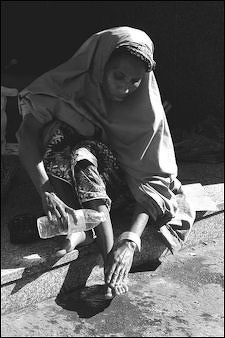
woman pilgrim participating in the Hajj
According to the BBC: “There is an Islamic tradition that women - and men - should not veil their faces while on the Hajj pilgrimage. Some hadith are used to support this view: “Yahya related to me from Malik from Nafi that Abdullah ibn Umar used to say that a man in ihram should not veil anything above his chin.” — Malik's Muwatta, Book 20, Number 20.5.13b “Yahya related to me from Malik from Nafi that Abdullah ibn Umar used to say that a woman in ihram should wear neither a veil nor gloves.” — Malik's Muwatta, Book 20, Number 20.5.15 (Ihram is the state of dress and ritual purity adopted for the Hajj.) [Source: BBC, September 3, 2009 |::|]
“Some Muslims dispute this and cite hadith in which the Prophet's wives pulled their head coverings over their faces in the presence of unrelated men while on Hajj. “Narrated Ibn 'Umar: A person asked Allah's Apostle, "What should a Muhrim (pilgrim on Hajj) wear?" He replied, "He should not wear shirts, trousers, a burnus (a hooded cloak), or clothes which are stained with saffron or Wars (a kind of perfume). Whoever does not find a sandal to wear can wear Khuffs, but these should be cut short so as not to cover the ankles.” — Sahih Bukhari, Volume 1, Book 8, Number 362 |::|
“According to this hadith, one man (Umar ibn al-Khattab, later the second caliph) was able to bring about the commandment for the Prophet's wives to veil their faces. “Narrated 'Aisha: The wives of the Prophet used to go to Al-Manasi, a vast open place (near Baqia at Medina) to answer the call of nature at night. 'Umar used to say to the Prophet "Let your wives be veiled," but Allah's Apostle did not do so. One night Sauda bint Zam'a the wife of the Prophet went out at 'Isha' time and she was a tall lady. 'Umar addressed her and said, "I have recognized you, O Sauda." He said so, as he desired eagerly that the verses of Al-Hijab (the observing of veils by the Muslim women) may be revealed. So Allah revealed the verses of "Al-Hijab".” — Sahih Bukhari, Volume 1, Book 4, Number 148
Different Veiling Customs
Islamic dress for women varies greatly from country to country and also region to region but the one thing that is constant is that at least the entire body is covered except for the hands and face. Many women cover themselves not because they want to are think it is right but rather because of family and cultural pressures to do so.
Different styles of veils include a red scarf worn with a black see-through chiffon cloth around the face worn in Cairo; a vivid green veil covering of red and gold floral print worn in Oman. Qatari women are said to favor veils made from silk while Arabian women favor blue cashmere and “Saudi crepe,” a new wrinkle-free material designed specifically for veiled women.
Traditionally girls began wear head scarves or covering themselves when the reached puberty and were eager to begin wearing such covering to show they were grown up. Customs, however, vary quite a bit from place to place and even family to family. In some cases girl start wearing covering not long after they are born. In other cases women don’t wear them until after they get married. In yet other cases women only cover themselves when they feel depressed or vulnerable or sense their death is imminent.
See Separate Article: DIFFERENT HIJAB AND MUSLIM VEILING CUSTOMS AND STYLES africame.factsanddetails.com
Image Sources: Wikimedia Commons
Text Sources: Internet Islamic History Sourcebook: sourcebooks.fordham.edu ; Arab News, Jeddah; “Islam, a Short History” by Karen Armstrong; “A History of the Arab Peoples” by Albert Hourani (Faber and Faber, 1991); “World Religions” edited by Geoffrey Parrinder (Facts on File Publications, New York); “Encyclopedia of the World’s Religions” edited by R.C. Zaehner (Barnes & Noble Books, 1959); Metropolitan Museum of Art, Encyclopedia.com, National Geographic, BBC, New York Times, Washington Post, Los Angeles Times, Smithsonian magazine, The Guardian, Al Jazeera, The New Yorker, Time, Newsweek, Reuters, Associated Press, AFP, Library of Congress and various books and other publications.
Last updated April 2024

